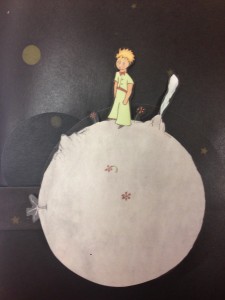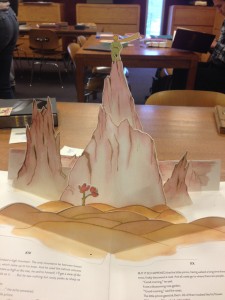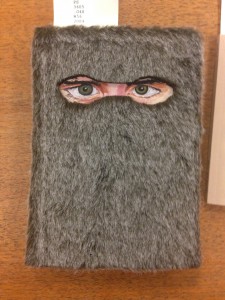On Wednesday our time in Special Collections was spent carefully handling rare, ancient objects, like clay tablets from 2,000 BCE, or a leaflet of the Gutenburg Bible, to help us think about books’ beginnings. Yesterday, we time traveled to recent centuries, where the bird’s-eye view is quite different. Jessy covered the tables in books that bless the modern world with their novelty, artistry, bright colors, and overall intrigue––for example, one of my favorites: The Little Prince as a pop-up book!


We perused and admired, asked questions silently and aloud. Then we each sat down and explained an object of interest. I attempted to talk about the mysterious “Fire Dogs” by Ken Campbell, Caitlin sympathized with a sneezing bear in “Little Fur Family,” Nate held up the beastly novel rendition of “Where the Wild Things Are.”

Eventually the discussion moved to a book that once graced the display case on the library’s second floor, at the start of the school year. It looks like a composition notebook, but it’s made of fabric and every word is embroidered. It’s called “Common Threads,” and Texas-based artist Candace Hicks (check out her website here) sold it to our collection at a discounted price of $925. “Maybe, if you divide that cost by the number of hours she spent on it, she was making minimum wage,” said Jessy. Indeed, the book is so intricate and must have taken a very long time, especially considering the artist was just starting to refine her craft. My classmate John brought up the inevitable question: why would someone do something so incredibly tedious?
We entered into a philosophical discussion of why we play sports, why we make jewelry, why we wrote poetry, why we play musical instruments. If not seeking fame or fortune, why do we engage in repetitive, tedious activities that fall under the category of “art?” What is it that we’re looking for?
My contribution included a reflection on last semester, when I didn’t set aside enough time to be creative. By the time it was ending, I noticed more and more my deep-seated frustration concerning my artistic endeavors, or rather, the lack thereof. I dabble in many mediums and feel that I’m mediocre at lots of things––collage-making, poetry, playing the piano––instead of learnéd and talented in one area, which seems like it would be far more satisfying in the long run. I envy my roommate who has played jazz trombone from a young age, and my other roommate who draws consistently and seems to be on a path toward common themes in her drawings. My urgent goal is to find the medium I enjoy the most (it might even be radio production), and put in my “10,000 hours.” This is obviously quite tedious and will require a lot of patience. But if I’m not actively pursuing this goal, I start to feel restless and unfulfilled.
The question still stands: why do human beings care so much to use their creativity? Why do we feel this intense need to use our hands? Even after reading up on the brilliant observations science has made on this subject, there’s a philosophical curiosity that can’t be satiated. So much is happening in the brain all at once when art is being made, or music being played, and we’ll never fully understand our own minds, so the mystery will go unsolved.
It was refreshing to look at books, and not just artists’ books, through this lens; naturally, writing of any kind is applicable to a conversation about creativity and expression. Even though we’ll never fully know why we feel the urge to write, at least we can rest assured that the urge will be there.